Like fire opals lit from within, freshly cured salmon eggs are ready to be served as ikura sushi, sprinkled on a bowl of rice (ikuradon), as a seafood garnish, with cream cheese and rice crackers, or simply gobbled by the spoonful!
At $40 to $50 a pound wholesale (and more expensive than that at the grocery store, when you can find it), cured salmon roe is not a regularly featured food in most kitchens. But if you catch your own salmon – or are friends with someone who does – it can be. Although the process of curing fresh salmon roe is somewhat time consuming, it is not difficult, and with patience almost anyone can turn out a sushi-grade batch of this delicacy.
These two matching skeins of eggs, or roe sacs, from a Chinook salmon were frozen this past summer and went into one of our ice chests when we flew to our home in Point Hope, Alaska this fall. Japanese chefs typically prefer the eggs of chum salmon (they’re big), but the eggs from any salmon species are fine. In fact, very attractive cured roe can be made from the smaller eggs of large char, too.
Whether you use fresh or fresh-frozen eggs, the first step (once the roe is completely thawed) is to separate the individual eggs from the skein. The riper the eggs, the easier this process will be. There’s a trick that makes this process much easier than it might otherwise be. Bring a pot of water to a temperature of about 120 degrees Fahrenheit and plunge the whole skein into the hot water. Remove the pot from heat and gently swirl the eggs around. You’ll probably want a pair of nitrile or plastic gloves for this. As you do this, you’ll notice the eggs becoming opaque – cream colored. They’ll look as though you’ve ruined the batch. You haven’t.
Hot water temporarily colors the roe and makes it easier to remove from the membranous roe sac. Provided you have kept the water temperature below 140° F, do not be concerned if your eggs become whiter and more opaque than those in the above photograph.
Next, pour the eggs and the water into a strainer. Plastic colanders, with their smooth surfaces, work well for this step. A lot of the extraneous tissue will drain off at this point. Place the strainer with the eggs in a large pot, fill with cold water, and continue to swirl the eggs around. The fat and other unwanted tissue will tend to rise above the eggs and can be skimmed off with a wire mesh skimmer. Some of the eggs will still have tissue attached. These can be cleaned by hand.
Left: Salmon roe separated and cleaned and ready to be cured. Right: the finished product – fresh, salty ikura.
The next step is magical. For each cup of salmon roe, add just less than a teaspoon of salt. Finely ground sea salt or kosher salt works best for this step. Gently but thoroughly mix the salt into the eggs with your hands. The eggs will immediately begin to turn bright and translucent. Taste and roe and, if desired, add additional salt.
Finally, place the eggs in a strainer one more time to allow excess liquid to drain off. The cured roe will keep for several days in the refrigerator. It can also be kept in the freezer in tightly sealed jars.
One you get the basic method down, you can substitute soy sauce for some of the salt or add a splash or two of sake (酒) to create subtly different flavors.
We serve ikura on everything from scrambled eggs to seafood pizza, as well as on traditional Japanese dishes such as chawan-mushi and zaru soba. Below, they add a splash of color and flavor to crepes wrapped around smoked Alaskan salmon and herbed cream cheese.

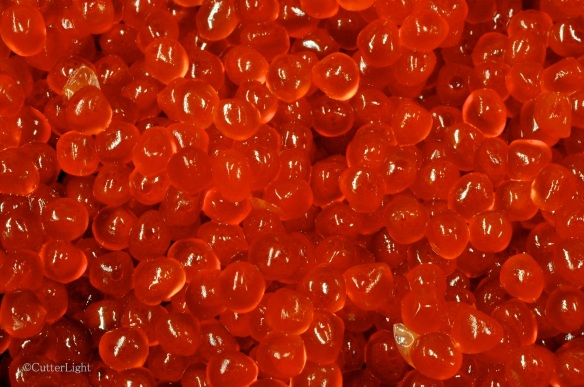
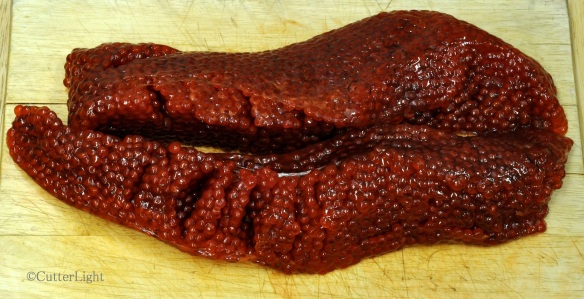
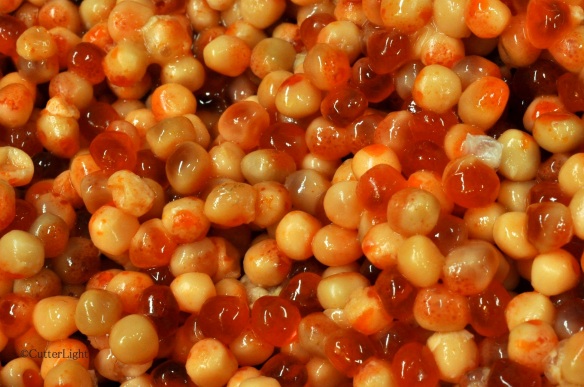
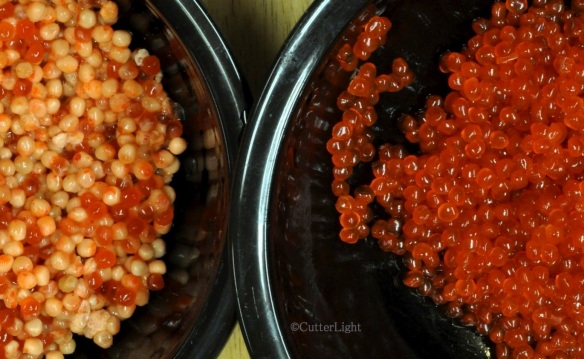
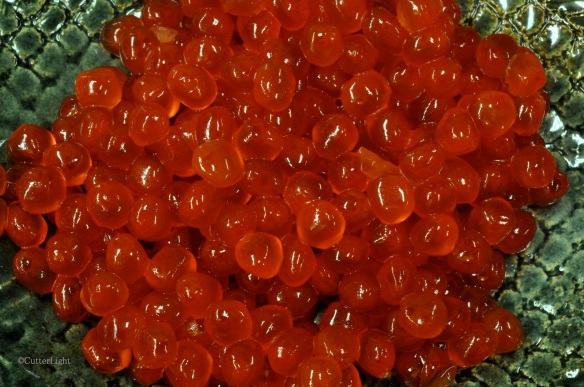
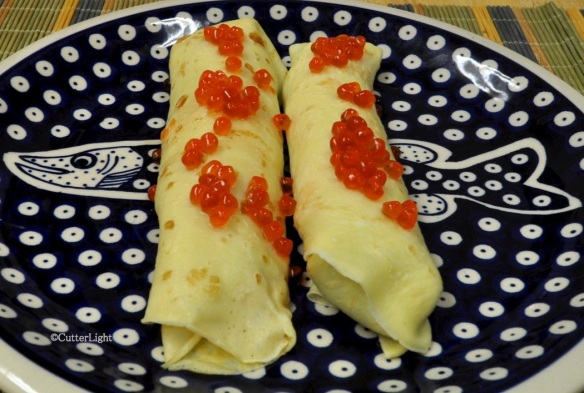
I don’t eat fish or the eggs but I loved the lesson! Thanks because of you I learned something new today:)
As always, Pam, thanks for reading! Just think of them as salty fire opals!
🙂
I learned something new today and love salmon roe – thanks so much for sharing! Have a Great One:)
Thanks!
Yum! I was kicking myself for not having you show us how to do that before we left on our trip. Next summer can’t wait to try.
You guys would love them!
I used to work in a smoked roe plant. We would smoke the eggs, jar, freeze the eggs. It was a fun job.
We’ve never had smoked salmon roe. Sounds tasty though!
Pingback: Four Weeks in Prince William Sound: Week 1 – Endless Sunshine | Alaskagraphy
Thanks for your easy instructions. Best that I’ve found on line and can’t wait to taste what I’ve prepared with your help.
Thanks for checking us out, Mary. Hope your roe comes out beautiful and tasty. One additional tip is that in our recipe, we used a relatively small amount of salt. Add a little more if desired. And let us know how it came out!
Is there any other way of obtaining the fresh roe that you know of? I don’t have access through friends or my own catch, but this looks like a really fun activity and with a wonderful result! Thank you for posting this. Very interesting!
Some Japanese grocers carry fresh roe from time to time, but it’s usually expensive. If you live in an area where a lot of salmon are harvested, fisherman often throw away the roe. You can ask for it at the docks where they clean their catch.
Thanks for this great and easy recipe. This is is by far the best method to separate eggs..thanks again for sharing this…mine turned out exactly as described and delicicous.
Thanks for reading, Faye. Glad to know this recipe worked for you. And if you ever want to try your hand at smoking salmon, trout or other fish to go with the eggs, give our salmon smoking recipe a go! Happy dining!
I was looking for a recipe to make edible salmon roe and your amazing photos caught my eye. I followed your lesson and made wonderful ikura! I think we ended up with about five cups and have already finished half of it! My dad is Japanese and he loved it so I must have done something right! I’ve subscribed to your blog and look forward to learning as much as I can from you. My fiancé and I are in Fairbanks now, and getting ready to move to Dillingham. Can’t wait… 🙂
Thanks for the feedback, Justin! We’ve heard so many good things about Dillingham… Happy fishing and dining! By the way, if you’re into smoking salmon, be sure to check out our recipe. We’ve gotten a lot of positive feedback on it. Jack & Barbra
That so didn’t work for me. Could not get the eggs to separate from the membrane and the fat. Ended up with a pile of broken eggs. I’m thinking that with thawed eggs they need to go into a cold water brine first to toughen them up a bit, but I really have no idea.
Hi Susan,
There are a few variables to consider: Frozen eggs should be fine. Your idea of toughening them with a soak in salt water could work. Also, make sure the water is hot enough when you start the separation process. Another important element is that the eggs must be mature. Mature eggs will separate fairly easily. Young eggs may not separate at all. Kind regards, Jack
Jack & Barbara,
My husband brings home about 55 reds from the Kenai each year. What would be the best way to preserve a bunch of eggs? Julie in Anderson
Our vote would be to prepare them according to the above instructions, then either put them in small jars or zip-lock freezer bags and freeze them. Or pre-freeze them on a tray (to firm them up) and then freeze them in freezer bags or vacuum-pack bags. The bags will allow for more efficient storage in the freezer. Pre-freezing them will prevent them from getting squished if you vacuum-pack them. They’ll stay good in the freezer for a long time preserved this way. JD
Thank you, JD. 27 years ago on my first AK adventure, I worked in the “egg room” at a cannery on the Kenai Peninsula. The Japanese soaked the skeins in a large vat of cold brine, then we carefully laid them into pine boxes, the top layer was salted, then boxes were closed with a pine lid nailed on and stacked. The excess liquid was given time to ooze out before they left the cannery. Are you familiar with this Japanese method? Do you know if the roe lasts a long time preserved this way, and with or without refrigeration? Just curious. I’m trying to learn food storage methods that don’t use electricity.
Thank you again,
Julie
Hi Julie. Thanks for the interesting note. The Japanese are experts in this field, and I’d be inclined to follow their example. But I don’t know much about how long roe cured in the fashion remains viable. In Japan, roe is typically kept refrigerated or frozen – but with so much salt in it, and some of the moisture removed, it makes sense that it might have a shelf-life at room temperature. We, too, are very interested in preservation methods that don’t require refrigeration, so please feel free to share further insights and questions. Thanks again. Jack
Jack & Barbara, One more question: how do you know when the eggs are not ok to eat any longer?
Thanks, Julie
Hi Julie. Smell and texture, with smell being the first tell. Bad eggs will smell “off” – rotten. Good eggs from a fish smell fresh. Good ikura smells pleasingly briny. Texture-wise, good eggs are firm (and bright). Bad eggs are soft – to the point of becoming gloppy.
Barbra & Jack, Yesterday I spotted nama-sujiko on sale at my local supermarket and I thought of you and this recipe you posted years ago…came back and saw this again! It must be a sign I have to give it a go…Adam
You’ll love it!
I made my own ikura! Thank you so much for the recipe (and you were right about loving it)!
Great! By the way, I recently cured Dolly Varden charr eggs in similar fashion. Much smaller than salmon eggs, but the same bright orange and similar flavor.
This was so helpful. I like the idea of making my own instead of spending tons at the local sushi joint. I can’t believe how everyone throws their roe away! This took a bit of patience, but was worth it. Thank you!
Yes, making ikura yourself definitely is a money saver. We’ve had very good success freezing our extra eggs – a good option if you end up with a lot.
This is great! Any particular tips for thawing frozen skeins? Or just toss them into the hot water as you would fresh? Thanks. Tyler
We thaw skeins by immersing them in cold water – still in the plastic freezer bag – and then waiting till their thawed. Hope your caviar comes out great!